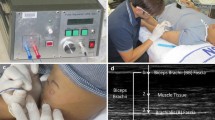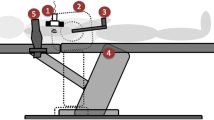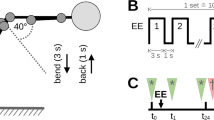Abstract
Delayed onset muscle soreness (DOMS) involves central and peripheral pain mechanisms. Referred pain patterns following stimulation of DOMS affected tissue have not been fully described. Referred pain may provide information on how central mechanisms are involved in DOMS, as referred pain is a central mechanism. Further, tendon tissue involvement in DOMS is not clear. This study assessed pressure pain threshold (PPT) sensitivity at the tendon, tendon–bone junction (TBJ) and muscle belly sites of tibialis anterior pre- and during DOMS in 45 subjects (34 males, 11 females). Furthermore, pain and referred pain areas at these three sites in response to hypertonic saline injection (n = 15 per injection site) were investigated pre- and during DOMS. DOMS was induced using controlled plantarflexion from a platform (bodyweight as resistance) causing eccentric contraction of the tibialis anterior muscle. DOMS induced PPT decrease was found at the TBJ and muscle belly sites only (P < 0.001). No mechanical effect was found in the unexercised limb. Maximal pain intensity induced by hypertonic saline given pre-DOMS was significantly higher for the tendon and TBJ injections compared to intramuscular injections (P < 0.05). Significantly higher referred pain frequency and enlarged pain areas were found at the muscle belly and TBJ sites following injection during DOMS compared to pre-DOMS. The results indicate that muscle belly and TBJ sites are sensitised while tendon tissue per se is unaffected by DOMS. Central sensitivity changes caused by DOMS may explain the increase in referred pain frequency and enlarged pain areas.






Similar content being viewed by others
References
Alfredson H (2003) Chronic midportion Achilles tendinopathy: an update on research and treatment. Clin Sports Med 22:727–741
Almekinders LC (1999) Anti-inflammatory treatment of muscular injuries in sport. An update of recent studies. Sports Med 28:383–388
Andersen H, Arendt-Nielsen L, Danneskiold-Samsoe B, Graven-Nielsen T (2005) Muscle hardness and spatial pressure sensitivity in delayed onset muscle soreness. Program No. 454-P60. In: Abstracts 11th World congress on pain. IASP, Seattle, p 174
Bajaj P, Graven-Nielsen T, Wright A, Davies II, Arendt-Nielsen L (2000) Muscle hyperalgesia in postexercise muscle soreness assessed by single and repetitive ultrasound stimuli. J Pain 1:111–121
Bajaj P, Graven-Nielsen T, Arendt-Nielsen L (2001) Post-exercise muscle soreness after eccentric exercise: psychophysical effects and implications on mean arterial pressure. Scand J Med Sci Sports 11:266–273
Bajaj P, Madeleine P, Sjogaard G, Arendt-Nielsen L (2002) Assessment of postexercise muscle soreness by electromyography and mechanomyography. J Pain 3:126–136
Baker SJ, Kelly NM, Eston RG (1997) Pressure pain tolerance at different sites on the quadriceps femoris prior to and following eccentric exercise. Eur J Pain 1:229–233
Barlas P, Walsh DM, Baxter GD, Allen JM (2000) Delayed onset muscle soreness: effect of an ischaemic block upon mechanical allodynia in humans. Pain 87:221–225
Brockett CL, Warren N, Gregory JE, Morgan DL, Proske U (1997) A comparison of the effects of concentric versus eccentric exercise on force and position sense at the human elbow joint. Brain Res 771:251–258
Brockett CL, Morgan DL, Proske U (2004) Predicting hamstring strain injury in elite athletes. Med Sci Sports Exerc 36:379–387
Carson RG, Riek S, Shahbazpour N (2002) Central and peripheral mediation of human force sensation following eccentric or concentric contractions. J Physiol (Lond) 539:913–925
Cook JL, Purdam CR (2003) Rehabilitation of lower limb tendinopathies. Clin Sports Med 22:777–789
Drewes AM, Helweg-Larsen S, Petersen P, Brennum J, Andreasen A, Poulsen LH, Jensen TS (1993) McGill Pain Questionnaire translated into Danish: experimental and clinical findings. Clin J Pain 9:80–87
Dutto DJ, Braun WA (2004) DOMS-associated changes in ankle and knee joint dynamics during running. Med Sci Sports Exerc 36:560–566
Fahlstrom M, Jonsson P, Lorentzon R, Alfredson H (2003) Chronic Achilles tendon pain treated with eccentric calf-muscle training. Knee Surg Sports Traumatol Arthrosc 11:327–333
Friden J, Lieber RL (2001) Eccentric exercise-induced injuries to contractile and cytoskeletal muscle fibre components. Acta Physiol Scand 171:321–326
Gibson W, Arendt-Nielsen L, Graven-Nielsen T (2006) Referred pain and hyperalgesia in human tendon and muscle belly tissue. Pain 120:113–123
Graven-Nielsen T, Arendt-Nielsen L, Svensson P, Jensen TS (1997a) Quantification of local and referred muscle pain in humans after sequential i.m. injections of hypertonic saline. Pain 69:111–117
Graven-Nielsen T, Arendt-Nielsen L, Svensson P, Jensen TS (1997b) Stimulus–response functions in areas with experimentally induced referred muscle pain—a psychophysical study. Brain Res 744:121–128
Graven-Nielsen T, Aspegren KS, Henriksson KG, Bengtsson M, Sorensen J, Johnson A, Gerdle B, Arendt-Nielsen L (2000) Ketamine reduces muscle pain, temporal summation, and referred pain in fibromyalgia patients. Pain 85:483–491
Graven-Nielsen T, Jansson Y, Segerdahl M, Kristensen JD, Mense S, Arendt-Nielsen L, Sollevi A (2003) Experimental pain by ischaemic contractions compared with pain by intramuscular infusions of adenosine and hypertonic saline. Eur J Pain 7:93–102
Gregory JE, Morgan DL, Proske U (2003) Tendon organs as monitors of muscle damage from eccentric contractions. Exp Brain Res 151:346–355
Hoheisel U, Mense S, Simons DG, Yu XM (1993) Appearance of new receptive fields in rat dorsal horn neurons following noxious stimulation of skeletal muscle: a model for referral of muscle pain? Neurosci Lett 153:9–12
Hoheisel U, Unger T, Mense S (2005) Excitatory and modulatory effects of inflammatory cytokines and neurotrophins on mechanosensitive group IV muscle afferents in the rat. Pain 114:168–176
Itoh K, Kawakita K (2002) Effect of indomethacin on the development of eccentric exercise-induced localized sensitive region in the fascia of the rabbit. Jpn J Physiol 52:173–180
Jones C, Allen T, Talbot J, Morgan DL, Proske U (1997) Changes in the mechanical properties of human and amphibian muscle after eccentric exercise. Eur J Appl Physiol Occup Physiol 76:21–31
Kawakita K, Miura T, Iwase Y (1991) Deep pain measurement at tender points by pulse algometry with insulated needle electrodes. Pain 44:235–239
Laursen RJ, Graven-Nielsen T, Jensen TS, Arendt-Nielsen L (1997) Quantification of local and referred pain in humans induced by intramuscular electrical stimulation. Eur J Pain 1:105–113
Lieber RL, Ljung BO, Friden J (1997) Sarcomere length in wrist extensor muscles—changes may provide insights into the etiology of chronic lateral epicondylitis. Acta Orthop Scand 68:249–254
Lieber RL, Shah S, Friden J (2002) Cytoskeletal disruption after eccentric contraction-induced muscle injury. Clin Orthop Relat Res S90–S99
Malm C, Nyberg P, Engstom M, Sjodin B, Lenkei R, Ekblom B, Lundberg L (2000) Immunological changes in human skeletal muscle and blood after eccentri exercise and multiple biopsies. J Physiol (Lond) 529:243–262
Malm C, Sjodin B, Sjoberg B, Lenkei R, Renstrom P, Lundberg IE, Ekblom B (2004) Leukocytes, cytokines, growth factors and hormones in human skeletal muscle and blood after uphill or downhill running. J Physiol (Lond) 556:983–1000
Marqueste T, Decherchi P, Messan F, Kipson N, Grelot L, Jammes Y (2004) Eccentric exercise alters muscle sensory motor control through the release of inflammatory mediators. Brain Res 1023:222–230
Melzack R, Torgerson WS (1971) On the language of pain. Anesthesiology 34:50–59
Morgan DL, Proske U (2004) Popping sarcomere hypothesis explains stretch-induced muscle damage. Clin Exp Pharmacol Physiol 31:541–545
Nie H, Kawczynski A, Madeleine P, Arendt-Nielsen L (2005) Delayed onset muscle soreness in neck/shoulder muscles. Eur J Pain 9:653–660
Nosaka K, Newton M, Sacco P, Chapman D, Lavender A (2005) Partial protection against muscle damage by eccentric actions at short muscle lengths. Med Sci Sports Exerc 37:746–753
Peterson JM, Trappe TA, Mylona E, White F, Lambert CP, Evans WJ, Pizza FX (2003) Ibuprofen and acetaminophen: effect on muscle inflammation after eccentric exercise. Med Sci Sports Exerc 35:892–896
Picavet HS, Schouten JS (2003) Musculoskeletal pain in the Netherlands: prevalences, consequences and risk groups, the DMC(3)-study. Pain 102:167–178
Proske U, Morgan DL, Brockett CL, Percival P (2004) Identifying athletes at risk of hamstring strains and how to protect them. Clin Exp Pharmacol Physiol 31:546–550
Purdam CR, Jonsson P, Alfredson H, Lorentzon R, Cook JL, Khan KM (2004) A pilot study of the eccentric decline squat in the management of painful chronic patellar tendinopathy. Br J Sports Med 38:395–397
Saxton JM, Donnelly AE (1996) Length-specific impairment of skeletal muscle contractile function after eccentric muscle actions in man. Clin Sci 90:119–125
Semark A, Noakes TD, St Clair GA, Lambert MI (1999) The effect of a prophylactic dose of flurbiprofen on muscle soreness and sprinting performance in trained subjects. J Sports Sci 17:197–203
Slater H, Arendt-Nielsen L, Wright A, Graven-Nielsen T (2003) Experimental deep tissue pain in wrist extensors—a model of lateral epicondylalgia. Eur J Pain 7:277–288
Slater H, Arendt-Nielsen L, Wright A, Graven-Nielsen T (2005) Sensory and motor effects of experimental muscle pain in patients with lateral epicondylalgia and controls with delayed onset muscle soreness. Pain 114:118–130
Stillwell D (1957) The innervation of tendons and aponeuroses. Am J Anat 100:289–317
Svensson P, Arendt-Nielsen L (1995) Effect of topical NSAID on post-exercise jaw muscle soreness: a placebo-controlled study. J Musculoskelet Pain 3:41–58
Taguchi T, Sato J, Mizumura K (2005) Augmented mechanical response of muscle thin-fiber sensory receptors recorded from rat muscle-nerve preparations in vitro after eccentric contraction. J Neurophysiol 94:2822–2831
Warden SJ, Brukner P (2003) Patellar tendinopathy. Clin Sports Med 22:743–759
Weerakkody NS, Whitehead NR, Canny BJ, Gregory JE, Proske U (2001) Large-fiber mechanoreceptors contribute to muscle soreness after eccentric exercise. J Pain 2:209–219
Weerakkody NS, Percival P, Hickey MW, Morgan DL, Gregory JE, Canny BJ, Proske U (2003) Effects of local pressure and vibration on muscle pain from eccentric exercise and hypertonic saline. Pain 105:425–435
Yahia L, Rhalmi S, Newman N, Isler M (1992) Sensory innervation of human thoracolumbar fascia. An immunohistochemical study. Acta Orthop Scand 63:195–197
Acknowledgement
The Danish Technical Research Council supported this work.
Author information
Authors and Affiliations
Corresponding author
Rights and permissions
About this article
Cite this article
Gibson, W., Arendt-Nielsen, L. & Graven-Nielsen, T. Delayed onset muscle soreness at tendon–bone junction and muscle tissue is associated with facilitated referred pain. Exp Brain Res 174, 351–360 (2006). https://doi.org/10.1007/s00221-006-0466-y
Received:
Accepted:
Published:
Issue Date:
DOI: https://doi.org/10.1007/s00221-006-0466-y




